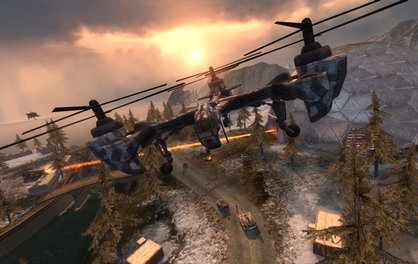Enemy Territory: Quake Wars - dev commentary
We talk Strogg with Splash Damage
Developers Splash Damage began as a bunch of fanboy modders, before growing into one of the UK’s most important games companies, creating Wolfenstein: Enemy Territory and most recently Enemy Territory: Quake Wars. We fought off Stroggs advancing on Bromley to ask art director Richard Jolly and creative director Paul Wedgwood about the making of this Quake-inspired tactical blaster and discover what it’s like working with a famous developer...
First ideas
Wedgwood: “I remember we flew the whole company out to E3 2003 in Los Angeles to celebrate Wolfenstein: Enemy Territory’s completion, and arrived to find there was a significant server crash bug in the release code. So what was meant to be a vacation ended up being seven days in the basement of Activision, trying to find a solution for this bug. Because we were tied up in the basement, Kevin Cloud at id and I were able to send this high concept for the next game back and forth. Up until that point there hadn’t really been much in the way of standalone multiplayer combat games - it had just been a component of a single-player game. We’d already been thinking about how it would be cool to have RTS elements, such as anti-personnel turrets or radar, on the battlefield and it just developed from there and became the basis for Quake Wars.”

Rejects
Wedgwood: “In Quake Wars, because we had these larger maps, we thought it would be fun if both teams could fight each other directly with the objective of destroying each other’s base. We stuck really rigidly to this for about six months trying to make it work, but what happened was that everyone wanted to be on the assault, so all the players would just run past each other to get to an empty base that was completely undefended! We also designed a combat role called the Gravitech which was all about the manipulation of game world physics and stuff.”
Jolly: “We went really overboard with the design of the bases - we had a factory in there producing the vehicles, and a lot of artwork that we ended up having to throw away. We built a complete command centre where you could re-equip and it ejected you out through doors...”
Wedgwood: “I think that’s where having the mentoring of id Software helped, because we only made big mistakes like that once. The guys at id were saying, ‘We don’t think base vs base is going to work. Why don’t you concentrate on the objective stuff ‘cos we know that works really well?’ So we returned to moving frontline gameplay. Because none of our founders came from the games industry, we’ve always been prepared to cut stuff that doesn’t work.”
Weekly digests, tales from the communities you love, and more
Strogg style
Jolly: “We came from a Quake III engine background with Wolfenstein: Enemy Territory, then made the jump to Doom 3. It was a whole new technology with so much to learn - how normal maps worked, lighting and stuff - so it took a good year until we got to the point where we had decent-looking art. I remember for the Strogg characters we were working on with Kevin Cloud [id Software’s lead artist and co-owner], we went through 45 different revisions to nail down the look - it was crazy the amount of work that went into it. The premise of Quake Wars is that it’s a prequel to Quake II, so we ended up with a more retro Strogg look. We looked at the Strogg and thought, ‘What would his father have looked like?’
“We took a lot of things from Quake II as well, such as the breather masks, and were able to take a bit of license with the other characters, so with the Oppressor class we had an open mouth which you’d never really seen in a Quake game before. Also, the brown armour from Quake I was very much the inspiration for the GDF.”


